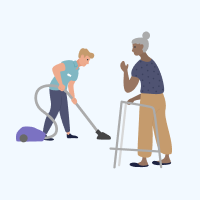If you are moving into an aged care home for permanent residential care, it’s important to understand what fees you may have to pay. And whether you are eligible for government assistance with your accommodation costs.
It’s a good idea to do this before you choose your aged care home. This information can help you make the right choice for your care needs and financial situation.
The types of fees and how much you pay will depend on:
- your income and assets, as assessed in your aged care means assessment
- the level of care you require
- the home you choose.
What does the government contribute?
What fees might I have to pay?
How do these fees work?
How do I find out my fees?
What if I can’t afford it?
Can I seek financial advice?
Aged care home costs pre-1 July 2014?
Aged care home fee scenarios
What does the government contribute?
The Australian Government subsidises aged care homes across Australia to provide affordable, accessible care. Residential care subsidies and supplements are paid directly to your aged care home.
The amount the government contributes is based on an assessment of your ongoing care needs once you have entered care. In addition, if your means assessment shows you have less capacity to pay, the government will contribute more.
What fees might I have to pay?
There are a number of costs associated with permanent care in an aged care home. The same costs also apply for palliative care in an aged care home. They include:
Care and accommodation costs
- Basic daily fee: An amount that everyone pays for the day-to-day services they receive at the aged care home.
- Means tested care fee: A contribution that some people pay toward the cost of their care, determined by a means assessment.
- Accommodation costs: An amount that some people pay to contribute towards or cover the full costs of their room, depending on their means assessment.
Other costs
Depending on which aged care home you choose and what you agree to with your provider, there are additional things you may be charged for. Unlike your care and accommodation costs, these fees are not set by the government. This means if you agree to them, you will need to pay the full cost yourself.
- Additional service fees: Fees for services that go beyond the minimum care and service requirements.
- Extra service fees: Some aged care homes offer extra service rooms and can charge for the bundle of upgraded hotel-type services provided.
Your aged care provider must record all these fees in your resident agreement, your accommodation agreement and, if needed, your extra services agreement. Your accommodation and extra services agreements may be merged into your resident agreement.
How do these fees work?
It’s important to understand how the different types of fees work before choosing your aged care home.
Basic daily fee
Everyone pays a basic daily fee. This fee helps pay for your day-to-day services such as meals, cleaning, facilities management, and laundry.
You pay this fee directly to your aged care home, generally on a fortnightly or monthly basis. The fee applies for every day you are a resident, including days when you might be away overnight—for example, on holiday or in hospital.
The basic daily fee is set at 85% of the single person rate of the basic age pension. The government updates it on 20 March and 20 September each year in line with increases to the age pension. Prices are published on the Department of Health and Aged Care website.
Based on current rates, the maximum basic daily fee is $63.82 per day, or $23,294.30 per year.
Means tested care fee
This fee is an extra contribution that some people pay, as determined through a means assessment. It is an ongoing fee towards the cost of your personal and clinical care.
The means tested care fee is different for everyone, and not everyone will have to pay it. If you do need to pay it, Services Australia will let you and your provider know the amount once you enter care.
Your means tested care fee will be between $0 and $406.39 per day. The maximum means tested care fee changes with indexation and is regularly updated on this site.
Your means tested care fee does not remain fixed when you enter an aged care home; it can change over time. Read more about how your aged care fees can change over time.
Do I need to pay a means tested care fee?
You can use our fee estimator to find out if you need to pay a means tested care fee and get an estimate of what the amount might be.
If you do have to pay a means tested care fee, you may need to complete a means assessment to find out the exact amount. Read more about means assessments and find out if you need to complete one using our Income and means assessments tool.
Annual and lifetime caps
Annual and lifetime caps apply to the means tested care fee. Once you reach a cap, you cannot be asked to pay any more in means tested care fees.
The caps are indexed on 20 March and 20 September each year. The cap amounts that apply to you are those that are current when you reach them, not those that were current when you entered care.
The maximum amount of means tested care fees an aged care home can charge you as of 20 March 2025 is:
- $34,311.23 per year, or
- $82,347.13 in a lifetime.
Note: Any income tested care fee you paid while you were receiving home care will also be counted towards the annual and lifetime caps if you move into an aged care home.
Accommodation costs
Everyone entering an aged care home needs to agree on a room price in writing with their provider before they enter care. Whether or not you need to pay the agreed amount will depend on your means assessment. As a general guide:
- If you’re not eligible for government assistance with your accommodation costs (not low means), you will pay the room price you agreed to with your aged care home as an accommodation payment.
- If you are eligible for government assistance (low means), the government will pay some or all of your accommodation costs to your provider. You will be asked to pay an accommodation contribution if the government does not pay the full amount. The amount you contribute is worked out by Services Australia based on your income and assets. It does not depend on your agreed room price. You (or your family) cannot be asked to pay or choose to pay the agreed room price.
Can my means status change?
Your status as low means or not low means is set based on your income and assets at your date of entry to an aged care home. It does not change while you remain in the same home, regardless of how your financial circumstances may change after entry. If your means increase after you have entered care, including if your family pays a refundable lump sum for your accommodation, it will not change your means status or the type of accommodation costs you pay (payment or contribution). However, it may increase your means tested care fee and/or accommodation contribution amount.
If you move to a new aged care home, you will need a new means assessment and your means status may change.
What are my accommodation payment options?
You have three options as to how you can pay for your accommodation:
- a refundable lump sum amount
- non-refundable daily payments, or
- a combination of both.
For detailed information about the different accommodation payment options, how each option works, and how to work out your costs, visit the Understanding aged care home accommodation costs page.
How much do I pay and how much does the government contribute?
If you can afford it, you are expected to pay for your room. However, help with some or all of the accommodation costs is available to those who need it. This is determined by a means assessment, but as a general guide:
- If you have income below $33,849.40 and assets below $61,500.00, the Australian Government will pay your accommodation costs.
- If you have income above $84,656.52 or assets above $206,663.20, you will need to pay for the full cost of your accommodation, negotiated and agreed to with the aged care home. (You may still need to pay the full cost of your accommodation if your assets and/or income are less than these amounts. Use the fee estimator to estimate the fees you can be asked to pay based on your income and assets.)
- If you need to pay for part of your accommodation, Services Australia will determine your contribution amount based on your means assessment. The Australian Government will pay the rest.
These income and asset amounts change with indexation and are up to date as at 20 March 2025.
More information on how the means assessment is used can be found in the How do I find out what it might cost me? section below, or you can try our Income and means assessments tool.
Additional service fees
Many aged care homes offer additional hotel-type services that you have to pay for. These services may include things like a preferred brand of toiletries, access to paid TV services, or arranging a hairdresser.
Some homes allow you to pick and choose what additional services you would like, so you only pay for what you use. Others may have a package of additional services they provide, and some of them must be agreed to as a condition of living in the home.
You and your provider must agree on a fee for additional services before you start receiving them. However, you can only be charged for additional services that you can make use of or benefit from. Because additional service offerings are specific to the provider, the fees for these services are set by the provider. They are not subsidised by the government.
Your home will be able to tell you what additional services they provide, their associated costs, and whether they are mandatory services that come with living at the home.
Extra service fees
Some aged care homes have “extra service” status. This means that they can provide residents with a higher standard of hotel-type services—including specialised menus, higher quality linen or particular room furnishings. This extra service status can apply to the whole home or just to individual rooms.
Aged care homes with this status can charge a regular extra service fee, which pays for a bundle of extra services. If you agree to enter an extra service room, you will have to pay this fee, whether or not you use the full bundle of extra services provided. The fee will be covered in your extra service agreement.
Extra service fees are set by the provider and are not subsidised by the government. You will have to pay the full costs.
You can ask your aged care home if they have extra service status and whether they charge a fee, or use the Find a provider tool. If your preferred home has extra service status, ask for their list of bundled services. That way you will know exactly what you are entitled to receive for your extra service fee.
How do I find out my fees?
Working out how much you will pay is a key step when deciding which aged care home is right for you. Before choosing a provider and agreeing to services, it’s a good idea to work out your costs through a means assessment, or at least get an estimate, so you know what to expect.
I want an estimate
You can use the fee estimator to get an idea of:
- the basic daily fee
- your means tested care fee, and
- whether you may be eligible for assistance with your accommodation costs.
Once that’s done, you can use the Find a provider tool to:
- see how much rooms cost,
- if the provider has extra service rooms, and
- find a room that is within your budget.
You will only know if the provider has additional service fees when you meet with them.
You can also use the income and assets checklist to get an idea of what financial information is taken into account.
I want to find out my actual costs
You will need an aged care means assessment to find out:
- whether you are eligible for assistance with your accommodation costs, and
- what your maximum means tested care fee will be. (You may pay a lower amount depending on your cost of care when you enter the aged care home)
Services Australia and the Department of Veterans’ Affairs (DVA) undertake means assessments for aged care. You may need to fill out a means assessment form to provide the financial details that Services Australia or DVA need to complete your assessment. Whether you need to complete a form will depend on whether you are receiving an Australian Government means-tested income support payment and whether you own your home.
Use our Income and means assessment tool to find out if you need to fill out a means assessment form, and which one to fill out.
What if I disagree with the results of my means assessment?
If you don’t think your means assessment is correct, you can ask Services Australia, or DVA if relevant, to review their decision. They will follow up with you on the next steps.
Fee advice letter
If you fill in and submit a means assessment form before you enter care, you will receive a fee advice letter from Services Australia once your assessment has been completed. The letter is valid for 120 days, unless there is a significant change in your circumstances.
Your fee advice letter will outline:
- your basic daily fee, and
- whether you are eligible to pay the agreed room price, or your maximum accommodation contribution, if any, and
- your means tested care fee, if any.
It will not outline:
- extra service fees — these will only apply if you enter an extra service room
- additional service fees — these will need to be discussed and agreed to with your provider.
Some people do not need to complete a form to have their means assessed because Services Australia or DVA already has their financial details. For example, if you receive a means-tested income support payment. If this applies to you, Services Australia will send you a fee advice letter once you enter care. It will confirm if you need to pay a means tested care fee and/or accommodation costs. If you require a fee advice letter before you enter care, you can call Services Australia on 1800 227 475.
If there is a change in your personal or financial circumstances, you’ll need to notify Services Australia (or DVA if relevant) so they can update your assessment and reissue your fee advice letter.
You should have your fee advice letter with you whenever you meet with potential aged care homes. The letter will advise if you are eligible for government assistance, or whether you can negotiate directly and pay the room price you agree to with the home.
What if I can’t afford it?
If you can’t afford your aged care home costs for reasons beyond your control, you can ask to be considered for financial hardship assistance.
Depending on your situation, you may apply for financial hardship assistance with your basic daily fee, means tested care fee, and/or accommodation costs. If you are eligible, the Australian Government will pay some or all of your aged care costs.
Note: You can’t receive financial hardship assistance for extra service fees or additional service fees, or if you are living in a multi-purpose service.
Learn more about financial hardship assistance.
Can I seek financial advice?
Yes, you can. In fact, it is recommended. Some accommodation payment methods may affect your pension and aged care fees. Also, if both you and your partner need access to aged care, each of your accommodation payment methods may impact the other’s aged care fees. So, it’s beneficial to seek independent financial advice before deciding how to pay for your aged care.
Services Australia’s Financial Information Service (FIS) is a free service available to everyone. FIS officers can show you how to make informed financial decisions. They can also help you to understand the financial implications of your aged care costs.
To find out more about FIS, or to make an appointment, call 132 300 and say “Financial Information Service” when asked why you are calling.
For more information and guidance on financial matters, you can also visit our financial support and advice page.
Aged care home costs for people who entered care before 1 July 2014
People who moved into an aged care home before 1 July 2014 will have their fees determined differently to those who move into a home from 1 July 2014 onward. For more information, see our aged care costs pre-1 July 2014 page.





